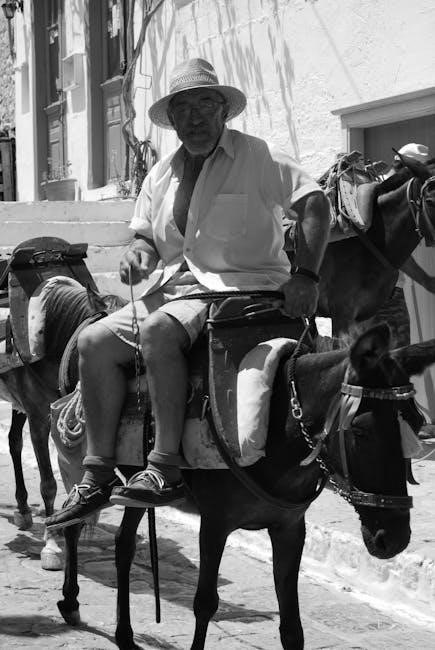A safari tour guide is an expert who enhances your wildlife adventure, ensuring safety, knowledge, and unforgettable experiences in nature. Their expertise enriches your journey, connecting you with diverse ecosystems and wildlife while promoting conservation efforts. With their guidance, you explore the wilderness, creating lifelong memories in Africa’s breathtaking landscapes.
What is a Safari Tour Guide?
A safari tour guide is an expert with in-depth knowledge of wildlife, ecosystems, and conservation. They are certified professionals, often holding qualifications like FGASA (Field Guides Association of Southern Africa), and possess skills in animal tracking, birdwatching, and survival techniques. Guides ensure safe and educational experiences, leading tours in vehicles or on foot. Their expertise enhances guests’ understanding of nature, while their storytelling and insights create memorable adventures. They are also trained in first aid and emergency response, ensuring a secure journey through the wilderness.
Importance of a Safari Tour Guide
A safari tour guide is crucial for a safe and enriching wildlife experience. They possess extensive knowledge of animal behavior, habitats, and local ecosystems, ensuring guests spot wildlife effectively. Guides also handle logistics, navigate terrain, and manage emergencies, providing peace of mind. Their expertise enhances understanding of nature and culture, creating unforgettable memories. Additionally, they promote conservation by educating travelers about environmental and wildlife protection, fostering a deeper appreciation for the natural world.
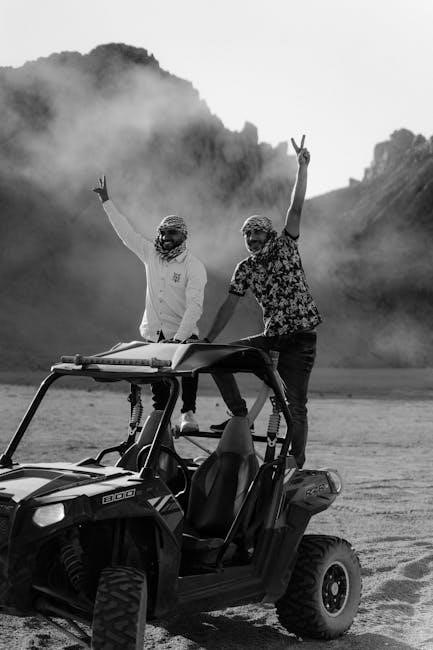
Role and Responsibilities of a Safari Tour Guide
A safari tour guide ensures safety, provides wildlife knowledge, handles logistics, and enhances the overall experience, making them indispensable for a successful and memorable adventure.
Duties of a Safari Tour Guide
A safari tour guide’s primary duties include planning routes, conducting tours, and ensuring safety. They identify wildlife, provide detailed information, and handle emergencies. Guides also manage logistics, such as transportation and accommodations, while maintaining a safe distance from animals. They interact with guests, answering questions and enhancing their experience. Their expertise in wildlife behavior and local ecosystems ensures unforgettable adventures, while their focus on conservation promotes sustainable tourism practices.
Qualifications and Skills Required
Safari tour guides must possess extensive knowledge of wildlife, ecosystems, and local cultures. They typically hold certifications in first aid and emergency response. Strong communication and interpersonal skills are essential for engaging guests. Physical fitness and stamina are required for long treks. Guides often have formal education in biology, ecology, or tourism. Proficiency in multiple languages and experience with wildlife behavior are advantageous. They must also have excellent navigation and problem-solving skills to handle unexpected situations in remote areas.
Experience and Knowledge of Wildlife
Experienced safari guides typically have years of hands-on knowledge of wildlife behavior, habitats, and migration patterns. They possess in-depth understanding of animal behavior, enabling precise tracking and identification. Guides often have extensive familiarity with local ecosystems, ensuring safe and informative tours. Their expertise allows them to predict animal movements and provide insightful commentary. This knowledge enhances the safari experience, offering guests unforgettable encounters with nature. Many guides also contribute to conservation efforts, furthering their understanding and commitment to wildlife preservation.

Types of Safari Tours
Safari tours vary, offering unique experiences: traditional for wildlife exploration, photographic for capturing moments, adventure for thrilling activities, and luxury for comfort and exclusivity in nature.
Traditional Safari Tours
Traditional safari tours focus on authentic wildlife experiences, often in open vehicles, allowing immersive exploration of natural habitats. Guides provide in-depth knowledge of flora and fauna, enhancing sightings. These tours emphasize connecting with nature, offering a classic adventure reminiscent of historic African explorations. They are ideal for those seeking a genuine, unfiltered encounter with the wild, fostering a deep appreciation for ecosystems and biodiversity under expert guidance.
Photographic Safari Tours
Photographic safari tours cater to enthusiasts seeking to capture stunning wildlife moments. Guides with expertise in both wildlife and photography lead these tours, ensuring optimal positioning for shots; Specialized vehicles equipped with camera supports and storage enhance the experience. These safaris allow ample time for photography, focusing on lighting, composition, and subject behavior. Ideal for professionals and hobbyists, they offer unforgettable opportunities to document Africa’s diverse wildlife in their natural habitats, creating lasting visual memories.
Adventure Safari Tours
Adventure safari tours offer thrilling experiences for those seeking more than traditional wildlife viewing. These tours often include activities like hiking, camping, and off-roading in rugged terrains. Guides expertly navigate these challenges, ensuring safety while delivering unforgettable experiences. Participants can explore remote areas, engage with nature, and enjoy immersive experiences like sleeping under the stars. Designed for the bold, these safaris combine wildlife exploration with adrenaline-pumping adventures, creating a unique and memorable journey into the African wilderness.
Luxury Safari Tours
Luxury safari tours combine opulent accommodations, gourmet dining, and exclusive wildlife experiences. These tours offer private game drives, expert guides, and access to secluded areas for intimate encounters with nature. High-end lodges provide lavish amenities, ensuring comfort and relaxation after thrilling adventures. Tailored itineraries cater to individual preferences, with activities like sunset champagne toasts and spa treatments. Perfect for discerning travelers, luxury safaris blend adventure with elegance, creating unforgettable experiences in Africa’s pristine wilderness while supporting conservation and local communities.
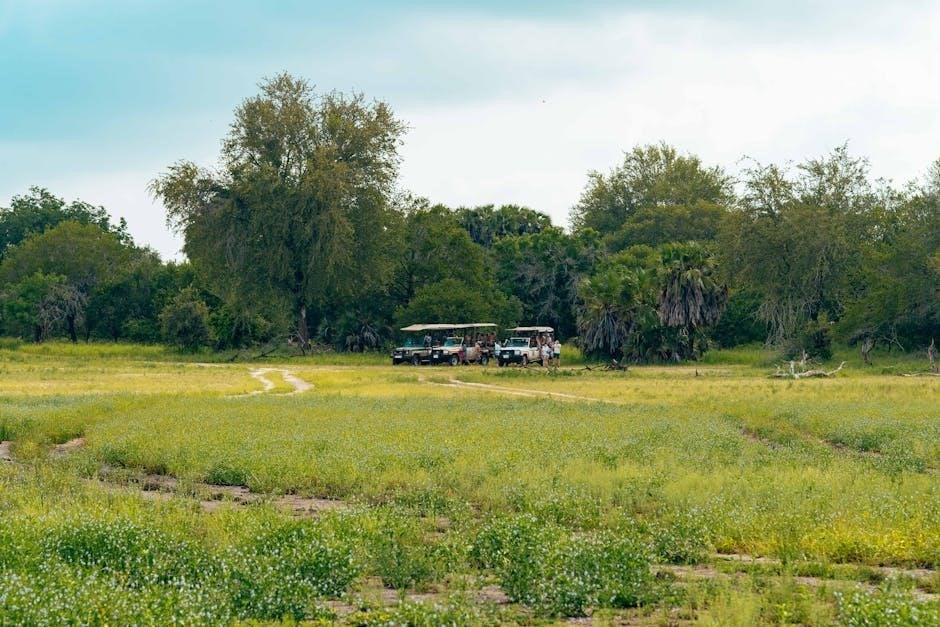
Planning and Preparing for a Safari
Research destinations, pack essentials like binoculars and attire, understand safety protocols, and budget wisely to ensure a smooth and enjoyable safari experience.
Choosing the Right Destination
Selecting the right destination is crucial for a memorable safari experience. Consider factors like wildlife seasons, park sizes, and animal diversity. Popular options include the Maasai Mara in Kenya, Serengeti in Tanzania, and Kruger National Park in South Africa. Each offers unique landscapes and wildlife viewing opportunities. Research the best times for migrations or specific species sightings. A knowledgeable safari guide can help tailor your choice based on your preferences and ensure an unforgettable adventure in Africa’s diverse wilderness.
Packing Essentials for a Safari
When preparing for a safari, pack wisely to ensure comfort and safety. Essential items include sturdy footwear, lightweight clothing, and neutral-colored attire to blend with the environment. Bring binoculars for wildlife viewing, a camera for capturing memories, and sunscreen for protection. Insect repellent, a first-aid kit, and reusable water bottles are must-haves. Include a hat, sunglasses, and layered clothing for varying temperatures. Check local regulations and pack accordingly to ensure a seamless and enjoyable safari experience.
Understanding Safety Measures
Ensuring safety is paramount during a safari. Always follow your guide’s instructions, as they are trained to handle wildlife encounters. Maintain a safe distance from animals and avoid sudden movements. Keep your seatbelt fastened in vehicles and stay alert while on game drives. Be aware of your surroundings, especially near water sources or dense vegetation. Never feed or approach wildlife, and avoid walking alone in remote areas. Stay hydrated, wear protective gear, and follow park rules to minimize risks and ensure a secure experience.
Budgeting for a Safari Tour
Budgeting for a safari tour involves planning for costs like accommodation, transportation, and guide fees. Research packages to determine what’s included, such as meals and activities. Set aside funds for optional excursions, like hot air balloon rides or night drives. Consider the time of year, as prices vary with seasons; Allocate extra for gear, tips, and visas. Plan realistically to avoid overspending, ensuring your safari remains affordable and enjoyable without compromising on quality or safety.
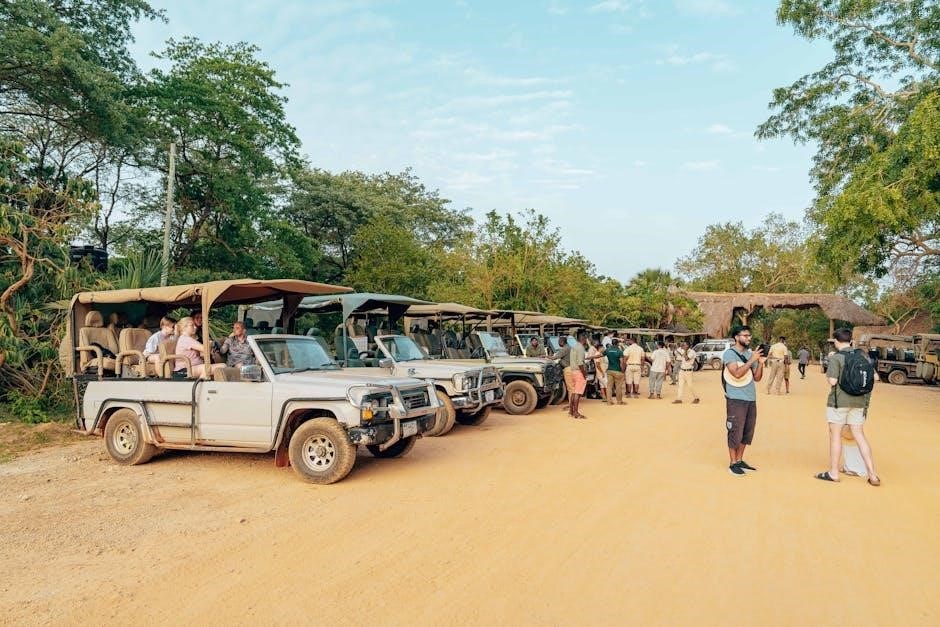
Wildlife and Nature on Safari
A safari offers breathtaking encounters with diverse wildlife and ecosystems. From majestic lions to graceful giraffes, the African wilderness showcases nature’s splendor, guided by experts who share deep knowledge of the land and its creatures.
Popular Wildlife to Spot on Safari
African safaris offer iconic wildlife experiences, with animals like lions, elephants, and zebras frequently sighted. The Big Five—lion, leopard, rhinoceros, elephant, and Cape buffalo—are major attractions. Giraffes, hyenas, and cheetahs also captivate visitors. Seasonal migrations, such as wildebeest herds, provide unique spectacles. Each species thrives in diverse habitats, from savannas to forests, making every safari a thrilling opportunity to witness nature’s beauty and diversity up close.
The Big Five Animals
The Big Five—lion, leopard, rhinoceros, elephant, and Cape buffalo—are iconic safari attractions. Originally named for their challenging nature, these animals symbolize Africa’s wild beauty. Lions, majestic predators, roam in prides, while leopards, elusive and agile, thrive in trees. Rhinos, with their imposing size, and elephants, the largest land animals, embody strength. Cape buffalo, known for their aggressive herds, complete this legendary group. Spotting all five is a highlight for many, showcasing diverse wildlife and the thrill of African safaris.
Birdwatching on Safari
Birdwatching on safari offers a unique opportunity to observe Africa’s vibrant avifauna. With over 1,000 species, the continent is a paradise for bird enthusiasts. From majestic eagles to colorful bee-eaters, safaris provide unparalleled access to diverse birdlife. Guided tours often include expert insights into bird behaviors, habitats, and migration patterns. Spotting rare species like the lilac-breasted roller or secretarybird adds excitement to the adventure. Binoculars and field guides are essential tools for maximizing this enriching experience, blending nature, education, and wonder in the wild.
Best Seasons for Wildlife Viewing
The best seasons for wildlife viewing on safari depend on the region and weather patterns. In Africa, the dry season (May to October) is ideal, as animals gather near water sources, making them easier to spot. The wet season (November to April) offers lush landscapes and newborn animals but can make wildlife tracking challenging due to dense vegetation. Timing your safari according to migration patterns, like the Great Migration, ensures unforgettable encounters with nature’s grandeur.

Cultural Experiences on Safari
A safari offers rich cultural experiences, allowing travelers to engage with local communities and learn about tribal traditions. Guides often facilitate interactions, enriching your adventure with authentic insights into indigenous lifestyles and customs, fostering cross-cultural understanding and appreciation.
Interacting with Local Communities
Interacting with local communities during a safari tour provides a unique opportunity to experience authentic cultural traditions and daily life. Travelers can visit villages, participate in rituals, and learn about customs, fostering meaningful connections. Guides often facilitate these interactions, ensuring respectful and safe exchanges. Such encounters not only enrich the safari experience but also support local economies and promote cross-cultural understanding, making the adventure more memorable and impactful.
Learning About Tribal Cultures
Learning about tribal cultures during a safari tour offers a fascinating glimpse into the traditions and way of life of indigenous communities. Guides often share insights into the history, customs, and daily practices of local tribes, enhancing your understanding of their unique heritage. This cultural exchange allows you to appreciate the rich diversity of tribal life, creating a deeper connection to the land and its people, while fostering mutual respect and appreciation for these vibrant communities.
Responsible Tourism Practices
Responsible tourism practices are essential for preserving the environment and respecting local communities during a safari tour. This includes minimizing waste, using eco-friendly products, and supporting conservation efforts. Guides emphasize the importance of maintaining a safe distance from wildlife to avoid disrupting their natural behaviors. By adhering to these practices, travelers contribute to the sustainability of ecosystems and ensure that future generations can enjoy the beauty of the wild. Ethical tourism fosters a harmonious relationship between visitors and the environment.
Supporting Conservation Efforts
Safari tours play a vital role in supporting conservation efforts by funding wildlife reserves and anti-poaching initiatives. Many guides collaborate with local organizations to protect endangered species and their habitats. By participating in eco-friendly tours, travelers contribute to the preservation of biodiversity. Conservation-focused safaris often include educational programs, raising awareness about the importance of wildlife protection. This direct support helps safeguard ecosystems and ensures the survival of Africa’s incredible natural heritage for future generations.
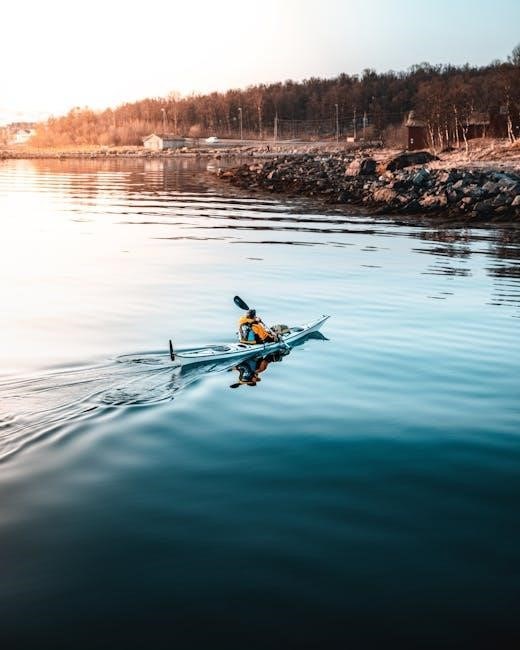
Photography on Safari
Photography on safari captures the thrill of wildlife and landscapes, requiring the right gear, techniques, and lighting to frame unforgettable moments in nature.
Best Camera Gear for Safari Photography
A DSLR or mirrorless camera with a telephoto lens (at least 200mm) is essential for capturing distant wildlife. Image stabilization ensures sharp images, while a wide-angle lens is ideal for landscapes. A tripod or bean bag helps stabilize shots in vehicles. Bring extra memory cards, batteries, and a polarizing filter to enhance colors. Protect your gear with a durable camera bag to withstand rugged conditions. Lightweight equipment is key for ease of travel during your safari adventure.
Techniques for Capturing Wildlife
Patience is key when photographing wildlife on safari. Anticipate animal movements and use fast shutter speeds to freeze action. Shoot during golden hour for soft, warm light. Get low for a compelling perspective and experiment with composition, like leading lines. Respect wildlife by maintaining a safe distance and avoid disturbing their natural behavior. Continuous autofocus and burst modes help capture dynamic moments. Blend into surroundings and stay calm to avoid startling animals, ensuring authentic and memorable shots.
Lighting and Composition Tips
Golden hour offers soft, warm light ideal for capturing wildlife. Avoid harsh midday sun for better results. Use leading lines, like tree branches or paths, to guide the eye. Frame subjects with natural elements for depth. Experiment with low angles to emphasize size and texture. Negative space can create dynamic, minimalist shots. Pay attention to lighting direction to highlight textures and forms. Burst mode helps freeze action in challenging light. Respect animals’ space and natural behavior for authentic compositions.
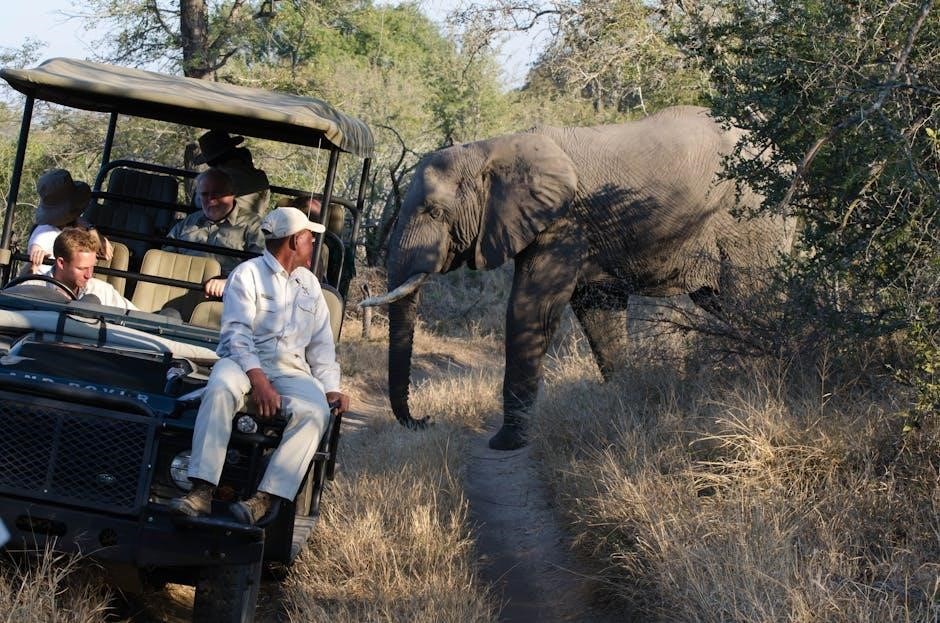
Safety and Emergencies on Safari
Always follow guide instructions and stay alert. Keep a safe distance from wildlife. Carry emergency supplies and stay hydrated. Be prepared for unexpected situations with a first-aid kit. Maintain vehicle safety protocols and avoid risky behaviors. Respect nature and wildlife to ensure a secure and enjoyable experience during your safari adventure.
Safety Tips for Safari Travelers
Always follow your guide’s instructions and stay alert. Keep a safe distance from wildlife and avoid sudden movements. Stay hydrated and wear appropriate clothing. Never leave the vehicle without guidance. Be mindful of your surroundings and avoid walking alone in remote areas. Respect wildlife habitats and maintain a calm demeanor. Carry essential supplies like water, sun protection, and a first-aid kit. Listen to weather advisories and stay prepared for unexpected situations. Prioritize your safety and the well-being of the environment.
Handling Emergencies in the Wilderness
Stay calm and follow your guide’s instructions. Carry a first-aid kit and know basic first aid. Keep emergency contact numbers accessible; Use a two-way radio or satellite phone for communication. Stay visible by wearing reflective clothing. Avoid wandering off alone and follow marked trails. Carry a whistle to signal for help. Keep essential supplies like water and a multi-tool handy. Always inform someone about your route and expected return time. Be prepared for unexpected situations and trust your guide’s expertise.
Health Precautions for Safari Goers
Consult your healthcare provider for vaccinations and medications. Ensure Yellow Fever vaccination if required. Use insect repellent with DEET to prevent insect-borne diseases. Wear protective clothing to avoid bites. Take malaria prophylaxis as prescribed. Stay hydrated and protect against sun exposure with hats and sunscreen. Avoid risky behaviors like swimming in unknown waters. Carry a first-aid kit and know how to use it. Follow food and water safety guidelines to prevent illnesses. Always inform your guide of medical conditions for emergency preparedness.

Reviews and Testimonials
Reading reviews from past safari travelers helps you evaluate tour guides and operators. Testimonials provide insights into service quality, expertise, and safety standards. Look for consistent feedback on guide knowledge, animal sightings, and overall experiences. Positive reviews often highlight unforgettable moments and professional guidance, aiding your decision in choosing the best safari tour guide for your adventure.
Importance of Reading Reviews
Reading reviews is essential for evaluating safari tour guides and operators. Reviews provide insights into service quality, guide expertise, and safety standards. They highlight experiences with wildlife sightings, accommodations, and overall satisfaction. Positive feedback often indicates knowledgeable guides, while negative reviews may reveal shortcomings. By analyzing multiple testimonials, you can make informed decisions, ensuring a reliable and unforgettable safari experience tailored to your expectations and preferences. This helps in selecting the best guide for your adventure.
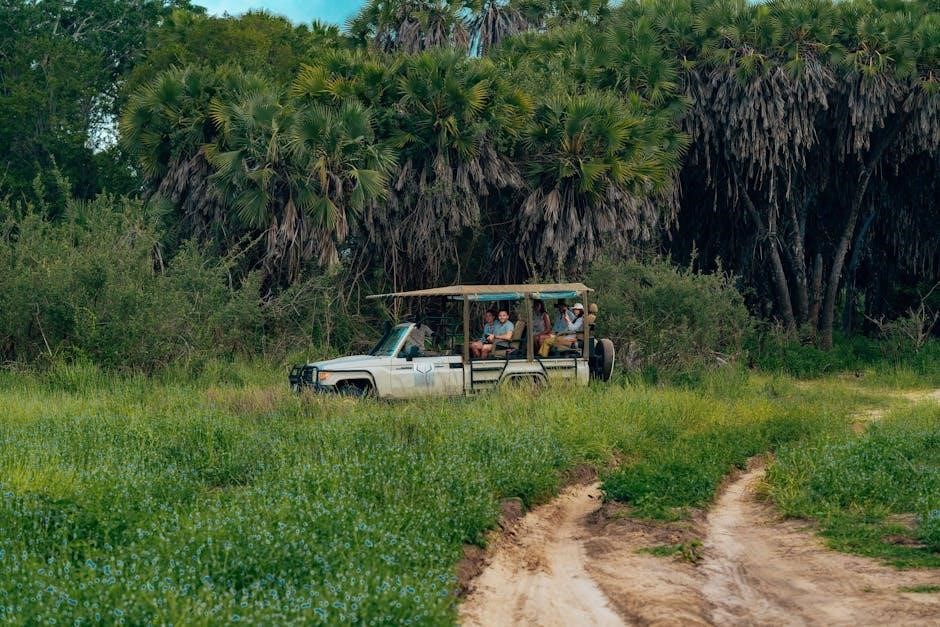
How to Research Safari Tour Guides
To research safari tour guides effectively, start by using search engines with specific keywords like “best safari tour guides” or “safari guide reviews.” Utilize advanced search options to filter by date or location. Check websites, social media, and travel forums for testimonials. Look for certifications from reputable organizations and verify their experience. Compare multiple sources to assess consistency and reliability. Pay attention to red flags such as poor reviews or lack of transparency. This ensures you find a trusted and skilled guide for your safari adventure.
What to Look for in Tour Reviews
When evaluating tour reviews, focus on detailed descriptions of experiences, guide expertise, and overall satisfaction. Look for consistency in feedback across multiple reviews. Check for mentions of safety, knowledge, and how well guides engaged with participants. Pay attention to specific highlights, such as wildlife spotting or cultural interactions. Be wary of overly negative or vague reviews. Use keywords like “expert guide” or “safari highlights” in your search to filter relevant feedback. This helps identify reliable and exceptional tour guides for your safari adventure.
